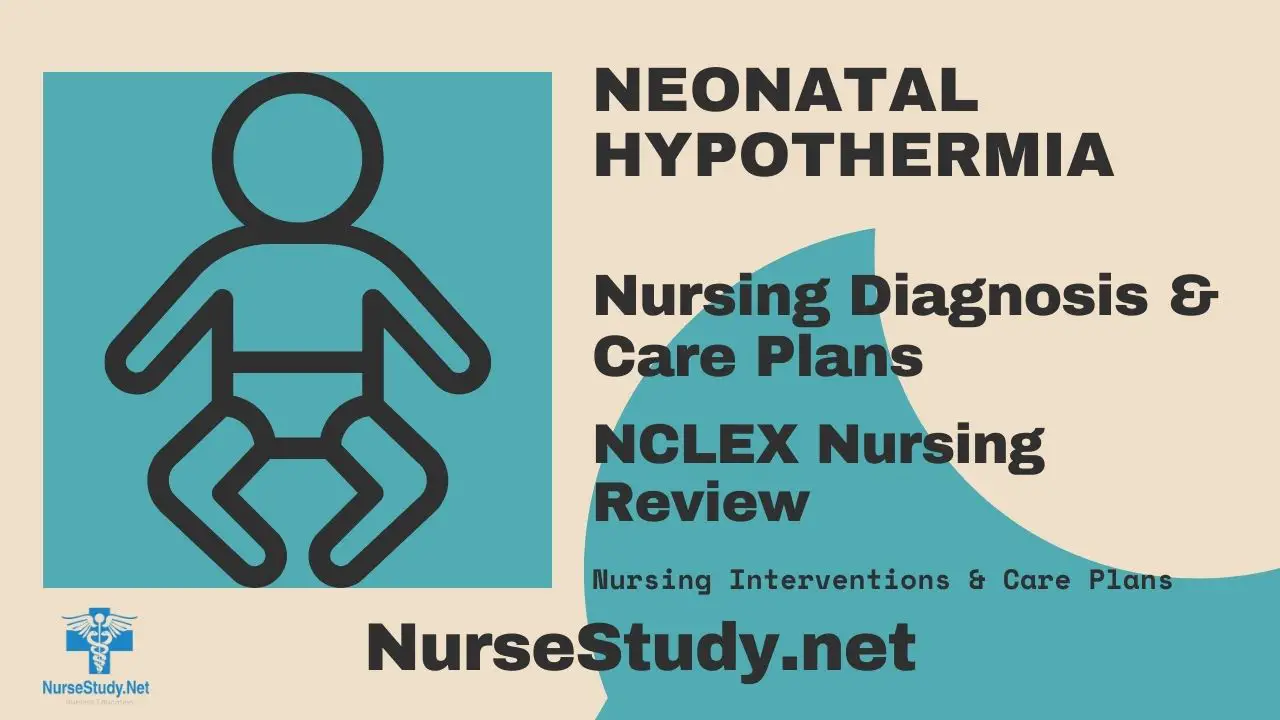Neonatal hypothermia is a serious condition where a newborn’s body temperature falls below 36.5°C (97.7°F). This nursing diagnosis focuses on identifying risk factors, implementing preventive measures, and managing hypothermia in newborns to prevent complications.
Causes (Related to)
Neonatal hypothermia can develop due to various factors affecting temperature regulation in newborns:
- Physiological factors:
- Large surface area to body mass ratio
- Limited brown fat stores
- Immature thermoregulation
- Thin skin with minimal insulation
- Environmental factors:
- Cold delivery room temperature
- Delayed drying after birth
- Premature removal from radiant warmer
- Cold surfaces or drafts
- Clinical conditions:
- Prematurity
- Low birth weight
- Sepsis
- Hypoglycemia
- Respiratory distress
Signs and Symptoms (As evidenced by)
Subjective: (Caregiver observations)
- Poor feeding
- Lethargy
- Weak cry
- Reduced activity
Objective: (Nurse assesses)
- Temperature below 36.5°C (97.7°F)
- Cold skin to touch
- Mottled appearance
- Peripheral cyanosis
- Respiratory distress
- Bradycardia
- Poor perfusion
- Metabolic acidosis
Expected Outcomes
- Newborn will maintain normal body temperature (36.5-37.5°C)
- Vital signs will stabilize within normal ranges
- Skin color and perfusion will improve
- Feeding patterns will normalize
- No complications will develop
- Parents will demonstrate an understanding of temperature maintenance
Nursing Assessment
Monitor Temperature
- Check axillary temperature every 30 minutes until stable
- Assess skin temperature gradient
- Document temperature trends
- Monitor environmental temperature
Evaluate Clinical Status
- Assess vital signs
- Monitor oxygen saturation
- Check perfusion
- Evaluate respiratory effort
- Assess feeding patterns
Check Risk Factors
- Review gestational age
- Assess birth weight
- Evaluate clinical conditions
- Monitor blood glucose
- Check maternal factors
Nursing Care Plans
Nursing Care Plan 1: Hypothermia
Nursing Diagnosis Statement:
Hypothermia related to immature thermoregulation and environmental factors as evidenced by temperature below 36.5°C and cold extremities.
Related Factors:
- Immature thermoregulation
- Large surface area to mass ratio
- Environmental temperature changes
- Limited subcutaneous fat
Nursing Interventions and Rationales:
- Place infant under radiant warmer
Rationale: Provides external heat source - Monitor temperature q15-30 minutes
Rationale: Enables early detection of temperature changes - Pre-warm all surfaces
Rationale: Prevents conductive heat loss - Use plastic wrap for premature infants
Rationale: Reduces evaporative heat loss
Desired Outcomes:
- Temperature will stabilize between 36.5-37.5°C
- Skin color will normalize
- Vital signs will remain stable
Nursing Care Plan 2: Ineffective Thermoregulation
Nursing Diagnosis Statement:
Risk for Ineffective Thermoregulation related to prematurity as evidenced by the inability to maintain a stable temperature.
Related Factors:
- Prematurity
- Limited brown fat
- Immature nervous system
- Thin skin barrier
Nursing Interventions and Rationales:
- Maintain a neutral thermal environment
Rationale: Minimizes energy expenditure - Cluster care activities
Rationale: Reduces the exposure time - Use appropriate humidity levels
Rationale: Prevents evaporative losses
Desired Outcomes:
- The infant will maintain a stable temperature
- Energy expenditure will be minimized
- Growth pattern will remain appropriate
Nursing Care Plan 3: Risk for Impaired Gas Exchange
Nursing Diagnosis Statement:
Risk for Impaired Gas Exchange related to cold stress as evidenced by increased oxygen demands.
Related Factors:
- Cold stress
- Increased metabolic demands
- Respiratory muscle fatigue
- Vasoconstriction
Nursing Interventions and Rationales:
- Monitor respiratory status
Rationale: Detects early signs of distress - Position for optimal breathing
Rationale: Improves ventilation - Provide oxygen as needed
Rationale: Supports increased demands
Desired Outcomes:
- Oxygen saturation will remain >95%
- Respiratory rate will normalize
- No signs of respiratory distress
Nursing Care Plan 4: Risk for Infection
Nursing Diagnosis Statement:
Risk for Infection related to compromised thermoregulation as evidenced by increased metabolic demands.
Related Factors:
- Temperature instability
- Immature immune system
- Increased metabolic stress
- Invasive procedures
Nursing Interventions and Rationales:
- Practice strict hand hygiene
Rationale: Prevents pathogen transmission - Monitor for infection signs
Rationale: Enables early intervention - Maintain skin integrity
Rationale: Preserves natural barrier
Desired Outcomes:
- No signs of infection will develop
- Temperature will remain stable
- Skin will remain intact
Nursing Care Plan 5: Ineffective Feeding Pattern
Nursing Diagnosis Statement:
Ineffective Feeding Pattern related to temperature instability as evidenced by poor sucking reflex.
Related Factors:
- Cold stress
- Increased energy expenditure
- Respiratory difficulties
- Lethargy
Nursing Interventions and Rationales:
- Monitor feeding tolerance
Rationale: Ensures adequate nutrition - Support appropriate feeding method
Rationale: Promotes safe feeding - Track intake and output
Rationale: Monitors nutritional status
Desired Outcomes:
- Feeding patterns will improve
- Weight gain will be appropriate
- Hydration status will remain adequate
References
- Abiramalatha T, Ramaswamy VV, Bandyopadhyay T, et al. Delivery Room Interventions for Hypothermia in Preterm Neonates: A Systematic Review and Network Meta-analysis. JAMA Pediatr. 2021;175(9):e210775. doi:10.1001/jamapediatrics.2021.0775
- Agourram B, Bach V, Tourneux P, et al. Why wrapping premature neonates to prevent hypothermia can predispose to overheating. J Appl Physiol (1985) 2010;108:1674–1681.
- Bee M, Shiroor A, Hill Z. Neonatal care practices in sub-Saharan Africa: a systematic review of quantitative and qualitative data. J Health Popul Nutr. 2018 Apr 16;37(1):9. doi: 10.1186/s41043-018-0141-5. PMID: 29661239; PMCID: PMC5902879.
- Lunze K, Yeboah-Antwi K, Marsh DR, Kafwanda SN, Musso A, Semrau K, Waltensperger KZ, Hamer DH. Prevention and management of neonatal hypothermia in rural Zambia. PLoS One. 2014 Apr 8;9(4):e92006. doi: 10.1371/journal.pone.0092006. PMID: 24714630; PMCID: PMC3979664.
- Lunze, K., Bloom, D.E., Jamison, D.T. et al. The global burden of neonatal hypothermia: systematic review of a major challenge for newborn survival. BMC Med 11, 24 (2013). https://doi.org/10.1186/1741-7015-11-24
- Lunze K, Hamer DH. Thermal protection of the newborn in resource-limited environments. J Perinatol. 2012 May;32(5):317-24. doi: 10.1038/jp.2012.11. Epub 2012 Mar 1. PMID: 22382859.
